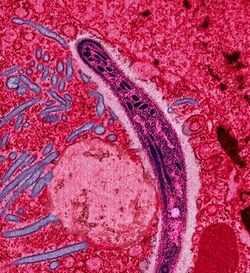Biology:Laverania
| Laverania | |
|---|---|

| |
| This shows a sporozoite of Plasmodium bergei migrating through the cytoplasm of midgut epithelia of an Anopheles stephensi mosquito. | |
| Scientific classification | |
| Domain: | Eukaryota |
| Clade: | Diaphoretickes |
| Clade: | SAR |
| Clade: | Alveolata |
| Phylum: | Apicomplexa |
| Class: | Aconoidasida |
| Order: | Haemospororida |
| Family: | Plasmodiidae |
| Genus: | Plasmodium |
| Subgenus: | Laverania Bray, 1958 |
| Species | |
|
See text | |
Laverania is a subgenus of the parasite genus Plasmodium. Infection with these species results in malaria. The subgenus was first described in 1958.[1]
The name was first proposed by Welch in 1897 as a genus name for the group now known as Plasmodium but for a variety of reasons the genus name Plasmodium was preferred.
Taxonomy
The first non-human primate parasites were described by Eduard Reichenow in Cameroon in 1920. He observed three morphologically distinct Plasmodium parasites in the blood of chimpanzees and gorillas in 1917.[2] These finding were later confirmed by other workers.[3][4] One species closely resembled P. falciparum and was thought to be the same species. This species was later renamed P. reichenowi.[5]
The other two species — P. rhodaini and P. schwetzi — have since been placed in the subgenus Plasmodium.[citation needed]
The noticeable differences between P. falciparum and the other known Plasmodium species led to the proposal that it be placed in a separate genus Laverania.[1] This suggestion was not accepted but the proposed name is now used as the subgenus.[citation needed]
Species
It has been proposed to rename P. gora and P. gorb as Plasmodium adleri and Plasmodium blacklocki respectively.[6] It has also been proposed that P. billbrayi be considered a junior synonym of P. gaboni.[6]
The full genomes of the seven species are now sequenced[7] and available on PlasmoDB.
References
- ↑ 1.0 1.1 Bray R.S. (1958). "Studies on malaria in chimpanzees. VI. Laverania falciparum". Am. J. Trop. Med. Hyg. 7 (1): 20–24. doi:10.4269/ajtmh.1958.7.20. PMID 13508992.
- ↑ Reichenow E. (1920). "Über das Vorkommen der Malariaparasiten des Menschen bei den Afrikanischen Menschenaffen". Centralbl. F. Bakt. I. Abt. Orig. 85: 207–221.
- ↑ Blacklock B.; Adler S. (1922). "A parasite resembling Plasmodium falciparum in a chimpanzee". Ann. Trop. Med. Parasitol. XVI: 99–107. doi:10.1080/00034983.1922.11684303. https://www.biodiversitylibrary.org/part/345713.
- ↑ Adler, S. (1923). "Malaria in chimpanzees in Sierra Leone". Ann. Trop. Med. Parasitol. 17: 13–19. doi:10.1080/00034983.1923.11684345. https://www.biodiversitylibrary.org/part/345652.
- ↑ Coatney, G.R.; National Institute of Allergy and Infectious Diseases (1971). The primate malarias. U.S. National Institute of Allergy and Infectious Diseases. https://books.google.com/books?id=9sidRhVXW1MC.
- ↑ 6.0 6.1 "A plethora of Plasmodium species in wild apes: a source of human infection?". Trends Parasitol. 27 (5): 222–9. May 2011. doi:10.1016/j.pt.2011.01.006. PMID 21354860.
- ↑ "Genomes of all known members of a Plasmodium subgenus reveal paths to virulent human malaria". Nature Microbiology 3 (6): 687–97. June 2018. doi:10.1038/s41564-018-0162-2. PMID 29784978.
"Plasmodium (Laverania)". NCBI Taxonomy Browser. https://www.ncbi.nlm.nih.gov/Taxonomy/Browser/wwwtax.cgi?mode=Info&id=418107.
Wikidata ☰ Q6502575 entry
 |

